I just finished testing the Nutrisense continuous glucose monitor (CGM) for the past two weeks, and I very much enjoyed the experience.
CGMs are unique because they provide immediate feedback on how your lifestyle choices impact your blood sugar response to food.
If you are interested in a CGM but are still determining if it is the right for you, keep reading to learn why I recommend trying out the Nutrisense.
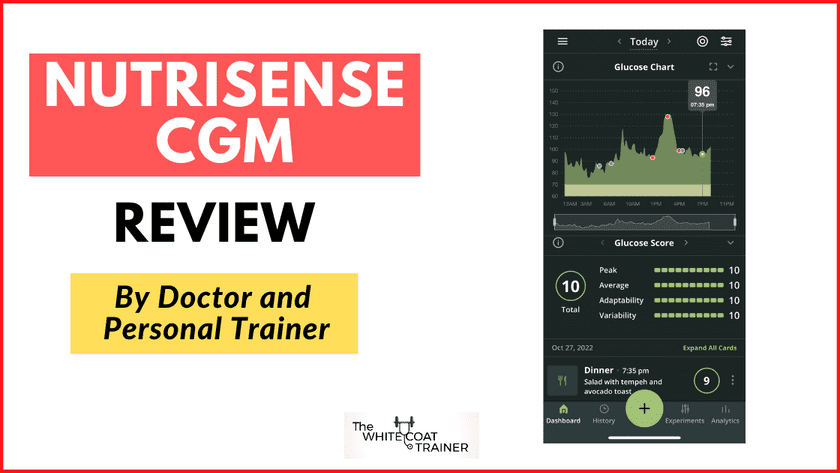
This post may contain affiliate links: meaning we may receive a commission if you use them.
What is Nutrisense?
Nutrisense is one of the most popular continuous glucose monitors (CGM) brands on the market.
A CGM is a small device you wear on your arm that continuously measures your blood glucose levels throughout the day and night.
You can see your glucose readings in real time on the Nutrisense app on your smartphone without having to prick your finger.
The app is designed to give you insight into your metabolic health so that you can immediately make informed choices about your diet and lifestyle.
The White Coat Trainer’s Nutrisense Review
Overall, I was really pleased with the Nutrisense CGM experience. Ordering, receiving, and installing the CGM was a seamless process.
Although the app could use some improvements, it is still user-friendly and provides unique insights that other apps don’t have.
Plus, you get your own private dietitian on-call to discuss your results!
Here’s what the entire process looks like in detail.
Ordering the Nutrisense
When you go to the Nutrisense.io website, you will take a short survey to discuss your health goals. It takes about 5 minutes to complete.
After the survey, you will choose between a monthly subscription (3, 6, or 12 months) or a non-commitment one-month plan.
You can get a $25 discount code as a White Coat Trainer reader by using WCT25 and following this link.
I was gifted one month to try out the program.
Questionnaire For Filling The Prescription
Shortly after ordering, you will receive a basic health questionnaire confirming some of your health information. You will also need to send a picture of your government ID to verify your identity.
Nutrisense needs this information because you can only get a CGM with a doctor’s prescription.
You will get approved in about 24 hours.
Getting and Unboxing the CGM
The Nutrisense kit arrives about a week after approval.
Inside the box, you get:
- The Freestyle Libre glucose sensor
- The sensor applicator
- Two alcohol swabs
- A sticker cover for the CGM (to keep the sensor clean and dry)
Installing The Sensor
At this point, you can download the Nutrisense app and log in. It will guide you step-by-step on how to install the sensor correctly in your arm.
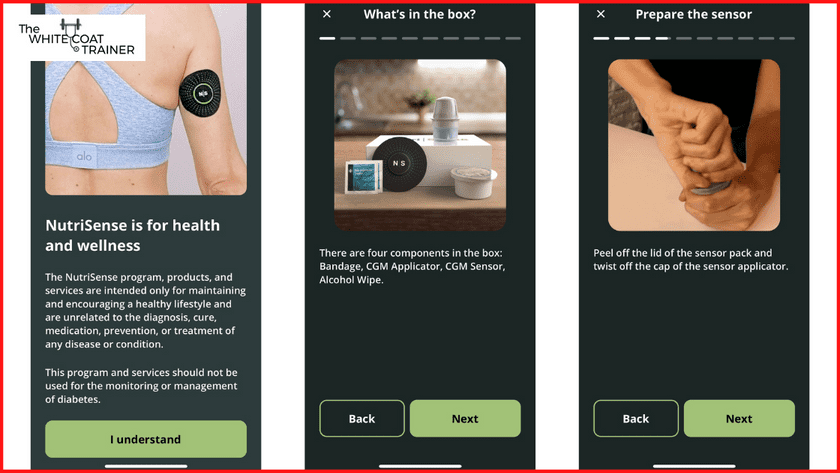
- Remove the cover lid on the Libre sensor.
- Next, unscrew the gray cap on the applicator.
- Align the applicator with the sensor and push down; you should hear a click
- Clean the fattiest area on the back of your arm with the alcohol swab
- Lastly, apply the sensor by pushing the applicator straight down into the back of your upper arm.
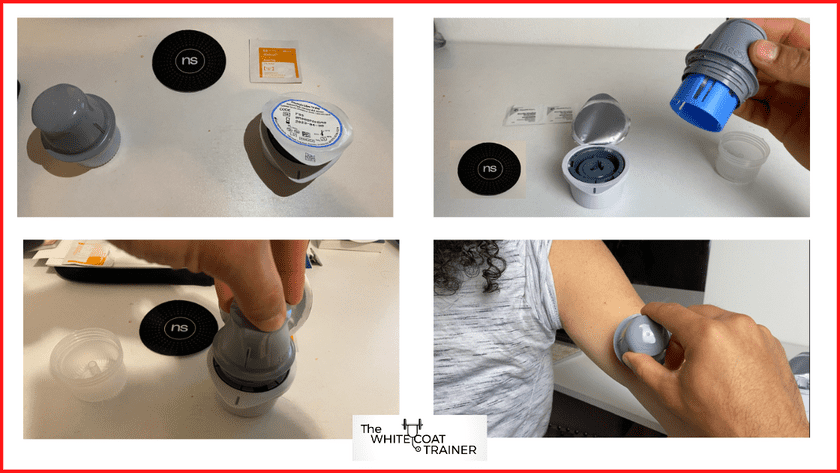
You might feel a little pinch or nothing at all.
Afterward, you will see the dashboard, where you track your blood sugar levels.
The app can also sync with other devices like an Apple Watch or Fitbit to track your exercise and sleep.
Here is a quick video showing what the process looks like:
Using the App and Getting Your Glucose Levels
Before you can get your glucose reading, you will need to wait one hour for the CGM to calibrate.
Once the hour is up, open the app and follow the instructions to scan your sensor.
You will need to scan the sensor with the selfie camera of your smartphone.
The cool thing is that you can do this as often as you’d like, and you can even scan the sensor through some clothes.
*Note: The sensor can only hold about eight hours of readings. Therefore, you must scan the sensor at least every eight hours to get a complete trend throughout the entire day.
Analyzing Your Results
The main dashboard screen lets you see your entire glucose trend throughout the day.
For the best information, you will have to input your meals manually so that you can see how your body responds to each meal.
Expect a spike in blood sugar ~one hour after eating a meal. The app will grade each meal and score it between 1 and 10 depending on how high your sugar peaked, how long it’s elevated, and how quickly your sugar levels recovered.
The higher the score, the better.
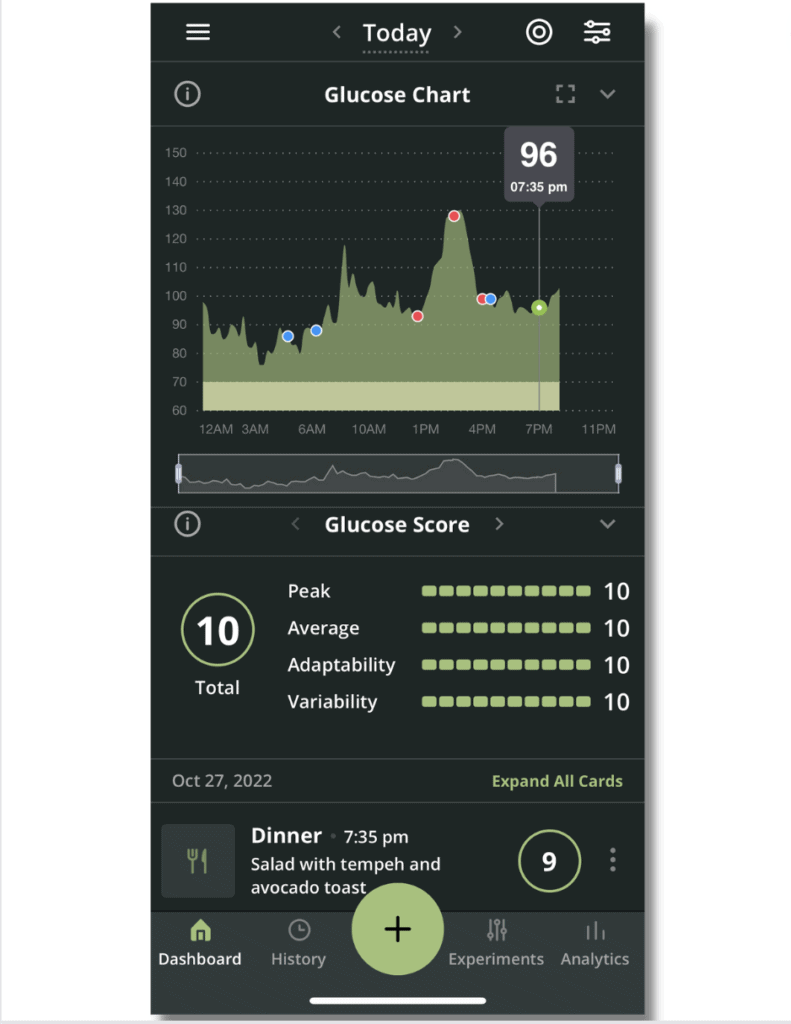
In addition, each day, you are given a score between 1 and 10. The score takes into account the following:
- how high of a glucose spike you experienced that day (the peak)
- what your average glucose levels were throughout the day (the average)
- how well your body adapted to the change in sugar levels, which is your insulin response (the adaptability)
- how variable your sugar was throughout the day, aka highs and lows (the variability)
You Also Get A Complimentary Dietitian!
In addition, Nutrisense gives you access to a dietitian for one month. You can chat with the dietitian directly in the app and receive personalized advice on improving your eating habits.
You can chat as much or as little as you like.
I already had a good idea of how my body responds to certain foods, but chatting with someone who has seen hundreds, if not thousands, of people’s sugar levels, was fantastic.
I asked her what some of the most shocking things she has discovered since seeing so much data, and I even learned several things from her.
Here I am chatting with her!
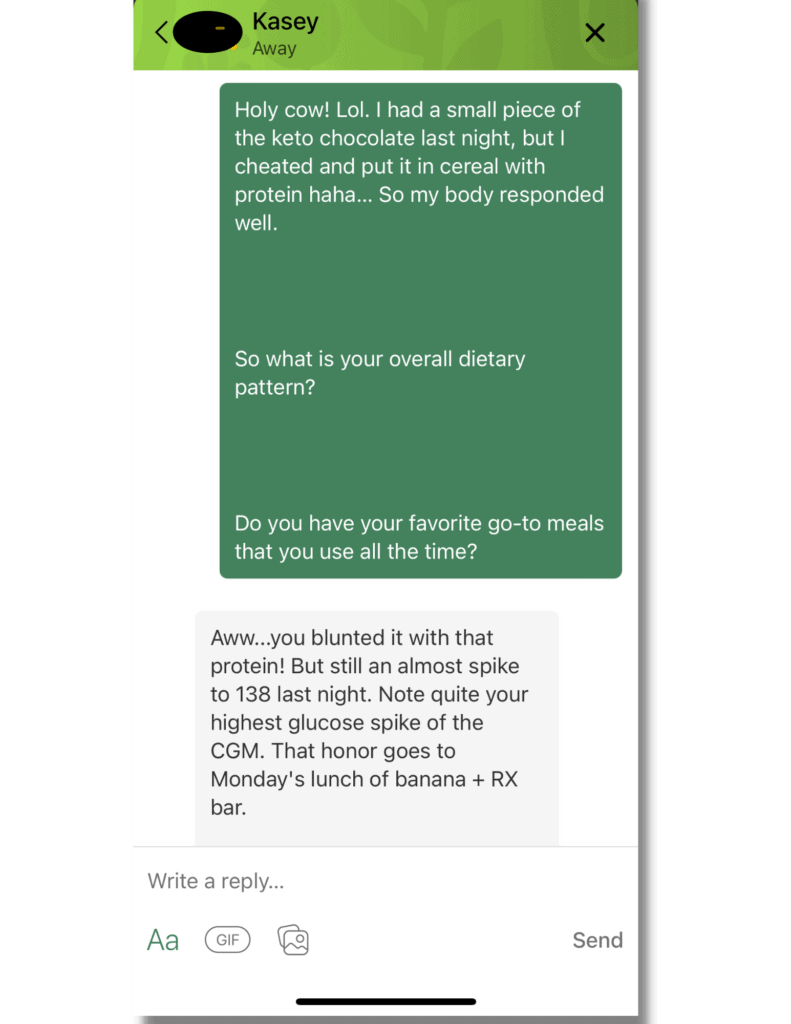
What I Didn’t Like About The Program
The only thing that I didn’t think was great was the app. Although the primary information (your glucose levels) is front and center, the app is a little busy with a ton of menus, widgets, and data to fill out.
I didn’t quite understand what half of the tools were for.
This isn’t a big deal, as you can get by without understanding everything in the app. I only cared about my trend, the score I received for each meal, and the overall daily score.
5 Key Takeaways I Learned From Using CGMs
The great thing about using a CGM is that everyone’s experience is unique.
What worked for me might not work for you, and vice versa.
That said, here are the five key takeaways that I learned from using CGMs that you can use to improve your overall health.
Exercise Is Uber Important for Metabolic Health
If you exercise regularly, you will significantly decrease blood sugar spikes.
I noticed that on the days when I worked out, my sugar would stay more stable throughout the day, and I would have fewer highs and lows.
This was especially true if I exercised before or after a meal. I could see as much as a 10-point difference if I exercised before or after a meal compared to when I wouldn’t.
If you can, take a short walk after each meal, especially if you ate a lot of carbohydrates.
Combining Macronutrients Is Key
Macronutrient balance is the best way to keep your blood sugar response in check.
If you can eat more protein, then do it. Protein helps stabilize blood sugar levels by slowing down digestion [Study].
Every time I added protein to a carbohydrate-rich meal, I was able to decrease the size of my post-prandial spikes.
For example, a banana spiked me to 150, but a banana with plain yogurt and chia seeds kept me in the low 100s.
I had a similar experience with oatmeal.
Fiber and fat can also help blunt the effects but to a lesser degree [Study].
Traveling and Sleep Deprivation Isn’t Great For Your Sugar Levels
It’s no secret that stress can impact your sugar levels [Study]. I put the CGM on the day before I took a 6-hour flight, sat in taxis to and from the airport, and experienced sleep disturbances.
Unsurprisingly, I got a 7 out of 10 in my overall metabolic scores on both days. While this score may not sound bad, I typically get a 9 out of 10 (and occasionally a 10/10 :)).
Thankfully, my body bounced back relatively quickly once I got home, and my average glucose levels stabilized.
So, if you have a bad day or two, don’t fret. Just get back on track. Your lifestyle choices over the long run have a much more significant impact than any one day.
Everyone’s Metabolism Unique
Last but not least, everyone is unique. Your blood sugar might increase significantly after eating one type of food but not another.
For example, Brittany grew up eating pasta for most of her childhood, as such, eating pasta dishes didn’t have as strong of an effect on her blood sugar as it did me.
Similarly, I can tolerate starchy vegetables better than she can. (I grew up eating them).
So, there is no one-size-fits-all approach to nutrition. Different foods will have different effects on your blood sugar.
In addition, even the same meal can have a different effect on your blood glucose levels depending on the time of day you eat it!
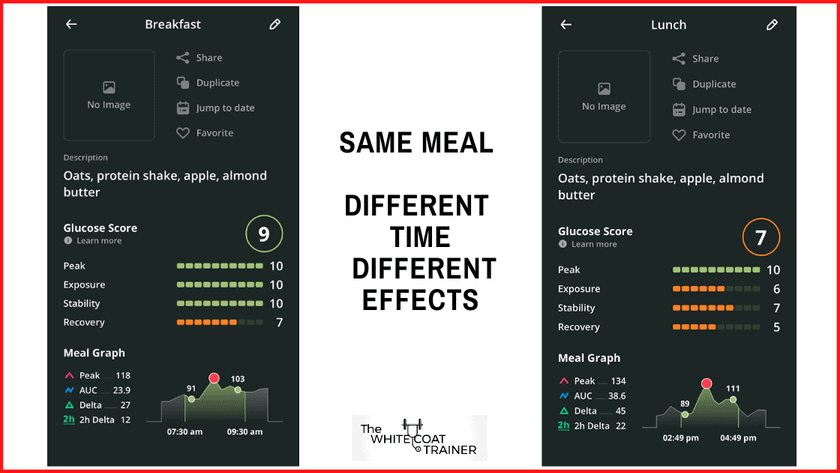
You’ll have to experiment and find what works best for you.
The Most Important Takeaway: You Get Actionable Insights
The best part about a CGM is that it can help you make better choices on the spot, using real-time data.
You can immediately get instant feedback on how your actions impact your sugar levels.
Whenever I was about to eat a carb-rich meal, I quickly thought about ways to make it more balanced.
Can I add any peanut butter? A tablespoon of olive oil? What about protein?
I also made better efforts to improve my sleep because I knew that would help keep my sugar levels in check.
Lastly, I was always inspired to go for a walk after each meal!
And with Nutrisense, knowing that a dietitian could see my scores was a great way to help me stay accountable!
Other Related Questions
Can Nutrisense Help You Lose Weight?
A glucose monitor has the potential to help you lose weight by promoting healthier lifestyle changes.
For example, if you see firsthand that eating certain carbs makes your blood sugar spike and crash an hour after eating them, you might be less likely to eat them.
Or, if you see that working out after a meal decreases your blood sugar spikes, you might be more likely to exercise regularly.
In addition, Nutrisense.io provides you with access to a dietitian who can help guide you with weight loss if that is your goal.
How Does The CGM Attach? Does It Use A Needle?
The CGM sensor uses a tiny needle that inserts just under the skin. It does not go into the muscle and is not as deep as a blood sugar finger prick.
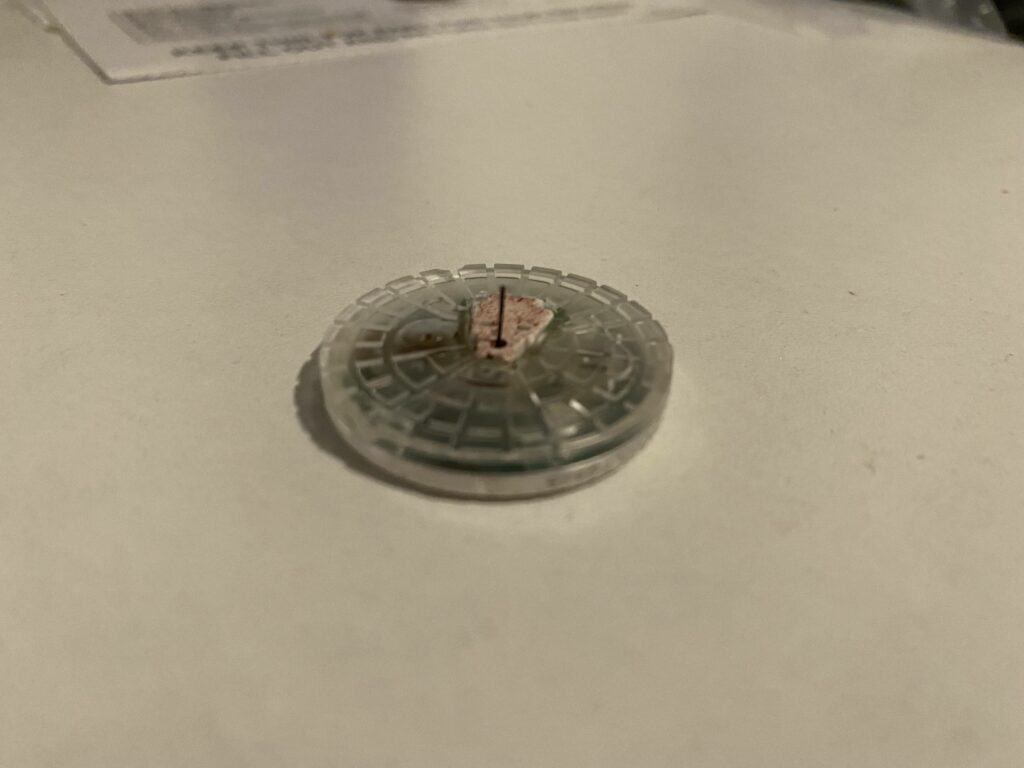
How Long Does The Sensor Last?
Each CGM sensor lasts for up to 14 days.
Which CGM Does Nutrisense Use?
Nutrisense uses the Abbott FreeStyle Libre (it cannot yet use the Dexcom G).
Can You Swim With It On?
According to the manufacturers, you can wear the sensor underwater for up to 30 minutes at a depth of 3 feet. However, you should not wear it in the sea (salt water).
Who Shouldn’t Use This?
These CGM sensors are for informational and educational purposes; you should not use them to diagnose or treat any medical conditions. Diabetic patients should follow up with their healthcare provider for regular check-ups.
How Much Does Nutrisense Cost?
At the time of this writing, a one-month supply of Nutrisense sensors costs $350. The cost is cheaper if you decide to commit to a 3-month or 6-month plan. However, you can get $25 off using the discount code WCT25 on this link.
I suggest you order a one-month supply and see how you like it (one month is plenty of time to get enough information).
You might also be able to use HSA money to pay for it.
How Does It Compare To The Competitors?
There are other CGM companies on the market, including Veri, Levels Health, and January.ai.
I have only tried Veri (you can read my Veri review here).
Veri has more competitive pricing; however, Nutrisense provides you with access to a private registered dietitian!
That feature may be worth the price of admission for some people.
Also, the CGM glucose data is more detailed with Nutrisense compared to Veri.
My Final Verdict On The Nutrisense Program
CGMs fundamentally change the way you think about your food and lifestyle choices.
Within a few days of wearing one, I was already making better choices and feeling more empowered.
Access to a nutrition coach was a nice bonus that I also enjoyed and believe many can benefit from.
Brittany and I had a great experience using Nutrisense, and we certainly recommend it.
If you’re looking for a way to improve your relationship with food and your health (and having a dietitian help you stay accountable) I recommend giving it a try.
Click here to take the quiz and use WCT25 to get $25 off your order.
Pros of The Nutrisense CGM Program
- Seamless process for ordering and setting up the wearable device
- Easy access to continuous blood sugar levels day and night
- A highly detailed scoring system to understand your glucose response for each meal
- You only need to use one app (some other companies require using two different apps)
- You can calibrate the sensor to improve accuracy (provided you have access to your glucose values from a finger stick)
- Access to a very knowledgeable concierge dietitian
- The Nutrisense team has excellent customer service
Cons of The Nutrisense CGM Program
- The price is a little steep
- The Nutrisense app is busy with a lot of menus and widgets, but the ease of use makes up for it
- The first 12-24 hours of blood sugar readings can be unreliable
- You must scan the sensor at least once every 8 hours to track your blood sugar levels for a full day
Overall, having access to continuous glucose monitoring data in an easy-to-use interface has been incredibly insightful.
To us, it is worth it.

Alex Robles, MD, CPT / Brittany Robles, MD, MPH, CPT
Alex & Brittany Robles are physicians, NASM Certified Personal Trainers, and founders of The White Coat Trainer: a resource dedicated to improving the health and fitness of busy professionals using time-efficient strategies. Their advice has been featured in My Fitness Pal, Prevention, Livestrong, Reader’s Digest, Bustle, The Active Times, and more. Learn more about them here.
References:
- Franz MJ. Protein: metabolism and effect on blood glucose levels. Diabetes Educ. 1997 Nov-Dec;23(6):643-6, 648, 650-1. doi: 10.1177/014572179702300603. PMID: 9416027
- Moghaddam E, Vogt JA, Wolever TM. The effects of fat and protein on glycemic responses in nondiabetic humans vary with waist circumference, fasting plasma insulin, and dietary fiber intake. J Nutr. 2006 Oct;136(10):2506-11. doi: 10.1093/jn/136.10.2506. Erratum in: J Nutr. 2006 Dec;136(12):3084. PMID: 16988118.
- Nowotny B, Cavka M, Herder C, Löffler H, Poschen U, Joksimovic L, Kempf K, Krug AW, Koenig W, Martin S, Kruse J. Effects of acute psychological stress on glucose metabolism and subclinical inflammation in patients with post-traumatic stress disorder. Horm Metab Res. 2010 Sep;42(10):746-53. doi: 10.1055/s-0030-1261924. Epub 2010 Jul 27. PMID: 20665427.
